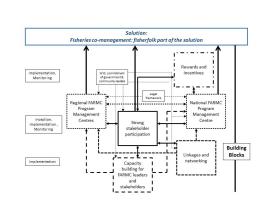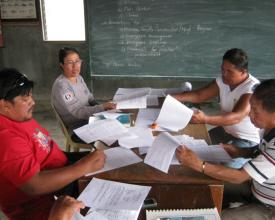Fisheries Co-management: Fisherfolk Part of the Solution
Full Solution
Looc FARMC: fish catch data collection (© Farmc Project Philippines)
Fisheries and Aquatic Resource Management Councils (FARMC) constituted by representatives from local fisherfolk, government, academia, civil society and private sectors serve as a legal forum to jointly discuss and decide solutions for the sustainable use of municipal marine resources. Through the FARMC resource users have a legal status and are actively involved in the management of fisheries and aquatic resources and take part in the decision making process.
Last update: 24 Sep 2025
7030 Views
Context
Challenges addressed
decreasing fish stocks caused by ineffective management and destructive fishing practices
Fish stocks are decreasing as a result of marine and freshwater habitat destruction, pollution caused by agricultural run-off and land based human activities, use of destructive fishing practices and over-fishing related to increasing population pressure. The solution addresses insufficient and ineffective fisheries management to ascertain income and livelihood of small-scale fishers at risk.
Location
Philippines
Southeast Asia
Process
Summary of the process
Each of the six building blocks contributes to the solution, however, strong stakeholder participation (building block 3) is the central element to bring together all other building blocks, and the main driver to make FARMC work (building blocks 1 and 2). Capacity building (building block 4) equips national and regional stakeholders with the necessary knowhow and skills, while linkages and networks (building block 6) helps to build partnerships for improving cooperation between stakeholders, and to provide technical and financial support. Rewards and incentives (building block 5) acts in a twofold way: it recognizes outstanding performance of local FARMCs and coordinators, but also stimulates innovations and multiplication of successful activities.
Existence and applicability of an enabling legal framework, will and commitment of government agencies and community leaders are key factors for the establishment of successful FARMCs and thus for accomplishment of the solution.
Building Blocks
National FARMC Program Management Centre
The Bureau of Fisheries and Aquatic Resources (DA-BFAR) established this national centre that implements and coordinates the national Fisheries and Aquatic Resource Management Council (FARMC) program of the Philippine government. It is charged with the facilitation, coordination and spearheading program implementation nationwide. Strategies and policies to enhance program execution are formulated and based on regular program evaluation.
Enabling factors
Conditions for adoption elsewhere:
• Legal framework (the 1998 Philippine Fisheries Code, Republic Act No. 8550 mandates the creation of FARMCs, defines responsibilities and authority of stakeholders and decisive engagement of fisherfolk in coastal resources and fisheries management. The Fisheries Administrative Order No. 196 defined FARMC implementation process).
• Will and commitment of government and community leaders;
• Funding and human resources.
Lesson learned
The support provided by governmental agencies and fisherfolk from local communities, including their leaders is a paramount factor of successfully establishing the FARMC and implementation of the programme.
Due to the legal framework and the strong cooperation and participation of all stakeholders concerned, government agencies and entities that were first unwilling to share power could be convinced to cooperate. However, this is a challenging process.
Solutions for inadequate financial and logistical support due to the lack of programme funding, and lack of technical personnel to provide assistance are common problems that need to be taken into account during the planning, inception and implementation phases. National and international partner organisations may be alternative options to be assessed.
Resources
Regional FARMC Program Management Centres
Regional FARMC Programme Management Centres established in every region of the Philippines facilitate all programme activities. Their designated programme coordinators work directly under the supervision of the Bureau of Fisheries and Aquatic Resources (DA-BFAR) regional directors. DA-BFAR supports the implementation at all levels both logistically and technically and in cooperation with partner agencies including local government units.
Enabling factors
Conditions for adoption elsewhere:
• Legal framework (the 1998 Philippine Fisheries Code, Republic Act No. 8550 mandates the creation of FARMCs, defines responsibilities and authority of stakeholders and decisive engagement of fisherfolk in coastal resource and fisheries management. The Fisheries Administrative Order No. 196 defined FARMCs implementation process).
• Will and commitment of government and community leaders;
• Funding and human resources.
Lesson learned
Resource users, when given the right opportunities in a proper context can be partners of the government for the management of fisheries and aquatic resources. They can be responsible resource users and be active participants in efforts targeting sustainable use of marine resources.
Adequate support mechanisms in terms of a legal framework and definition of responsibilities and authorities, technical expertise, funding and logistics are needed to make co-management successful.
Co-management poses many challenges requiring perseverance, commitment and strong conviction of all partners and stakeholders to overcome the many constraints and difficulties for planning and implementing co-management.
Resources
Inclusion of Fisherfolk Leaders
Regular participation and consultation of fisherfolk leaders is sought from the beginning. These leaders are appropriate advocates for responsive and effective co-management planning and implementation since they are directly affected and speak the language of coastal dwellers.
Enabling factors
Conditions for adoption elsewhere:
• Community leaders who are willing to sacrifice their time and share their talents for the common good.
• Government workers who genuinely believe in the principle of people empowerment, social equity, partnerships.
Lesson learned
Regular consultation and consideration of input from stakeholders at community level, including fisherfolk and their leaders from formulation of implementing guidelines up to policy implementation is a key factor for ownership and empowerment.
Involving resource users in the management process makes them aware of resource status and need for proper management to sustain the basis for their livelihood. Awareness favours active participation, cooperation and compliance with rules and regulations.
Contributions of fisherfolk and other resource users based on their local knowledge and long experience in the target area are complementary to scientific and technical expert input.
Financial valuation of ecosystem services makes aware resource users of the economic importance of ecosystems that they rely on. It is effective in helping decision makers and managers to prioritise fisheries and aquaculture.
Capacity Building for FARMC Members
Continuous training equips stakeholders with the necessary know-how and skills to set up and run a FARMC. It includes assistance on habitat assessment and monitoring, the establishment and management of marine protected areas (MPAs), mangrove rehabilitation, fisheries law enforcement, integrated coastal zone management (ICZM) and impacts of climate change on marine ecosystems.
Enabling factors
Conditions for adoption elsewhere:
• Adequate support mechanisms and resources are needed to provide the required and necessary technical expertise.
Lesson learned
Capacity building increases the council’s knowledge and expertise. Confidence thus acquired boosts commitment and participation of beneficiaries thus contributing to increase achievement of objectives set.
Site-specific training for core group building proved useful to enhance leadership capabilities of FARMC leaders. The design of all interventions at community level making understanding easy, particularly for participating fisherfolk created awareness among stakeholders of the important role that they play in resource management in their localities. Stakeholders turned from distant beneficiaries of a governmental programme into active participants in its implementation.
Rewards and Incentives
The national incentive system for FARMC, a regular programme in BFAR, serves to recognize outstanding FARMCs and FARMC coordinators that may act as role models. It includes cash prizes, trophies and appreciation by the President of the Philippines that are regularly awarded in accordance to a nationwide evaluation process.
Enabling factors
Conditions for adoption elsewhere:
• Governmental recognition of the importance of fisheries and aquaculture
• Governmental acknowledgement of efforts and achievements due to cooperation amongst stakeholders, particularly the contributions by local fisherfolk.
Lesson learned
The recognition of good work and leadership is appreciated and helps to sustain if not boosting participation, commitment and engagement of FARMC stakeholders and coordinators. It enhances partnership and cooperation amongst group members and creates healthy competition amongst FARMCs. Champions act as models for emulation and inspiration of other and new FARMCs.
It is, however, important to establish a transparent and equitable evaluation and awarding process.
Partnerships and Networking
Partnerships with research, government and civil society institutions help FARMCs in the planning, implementation of their activities and achievement of their objectives.
Enabling factors
Conditions for adoption elsewhere:
• Accessible partners in public, research and private sectors, including foundations, NGOs, private persons, research agencies and universities, who are convinced that the FARMC can make a difference, and who are willing to contribute and to support FARMC in terms of funding and technical expertise.
Lesson learned
Assistance from partners can help to balance shortcomings from government authorities and institutions. Cooperation with civil society organisations has demonstrated significant contributions, particularly in the field of capacity development. It is important to liaise with cooperation partners for technical support in providing orientation about the nature of FARMCs and to adjust their input and contributions appropriately to meet needs and capacities of beneficiaries.
Impacts
FARMC is a successful social reform measure covering 99% of the Philippine’s coastal municipalities and cities. Fisherfolk became part of the solution and is involved in all steps of sustainable fisheries management processes. Partnerships and community leaders emerged adding social resilience. They help in establishing fish sanctuaries, marine protected areas, fisheries regulations and compliance.
FARMC and Fish Catch Monitoring and Database Management System tested for nationwide application.
Fish catch increased where FARMC works, improving livelihood of fisherfolk.
Beneficiaries
small-scale, subsistence fisherfolk, local government units as well as civil society
Story
Where FARMCs have been established and work seriously, things have changed: fish catch for small-scale fishers is on the rise again. In Bani, Pangasinan, they have increased from 1-2 kg to 10-15 kg daily and a 40 kg yellowfin tuna now is usual. Well maintained mangroves, coral reefs and giant clam gardens have started to attract tourists. “If only there will be a strong and functional FARMC in each coastal village, then we will have bountiful seas again,” says Blademir Mancenido, member of the National Technical Committee that evaluates candidates nationwide for outstanding FARMCs.
When a fisherman in the Philippines claims, “Our government cannot manage our coastal resources on its own, it needs us fisherfolk. We are part of the solution,” he will most likely be a member of a FARMC. These local councils have empowered fishers who had previously felt helpless and abandoned by politics. “Because of the creation of the FARMC, the fisherfolk’s perspective were challenged, provoking a changing of mind-set that gives more respect towards their resources, and installing a sense of ownership and responsibility,” shared former Mayor Arturo Maristela of Aroroy in Masbate.
A commercial fisher in Lupon, Davao Oriental, Cristituto Decena admitted that he perceived the FARMC as “berdugo ng mga mangingisda" (executioner of fisherfolk) because they do not allow illegal fishing and apprehend users of illegal fishing gears. But when he became a FARMC member he began to understand the council’s purpose and the need to protect marine resources.
There are many turnaround stories such as illegal fishers who are zealous protectors of the sea now and who volunteer to guard municipal waters against poachers and illegal fishing. ‘We used to look for the biggest and most beautiful corals to put the poison, but now we are helping find even the smallest corals so we can protect it by establishing a fish sanctuary,” says a self-confessed cyanide fisher who became a member of FARMC in Northern Lamon Bay.
People now plant mangroves instead of contributing to their denudation and return marine turtles to the wild after tagging instead of eating or selling them. FARMC members are among the first responders to stranded marine mammals to guide them back to the sea instead of slaughtering and selling them. "It was the FARMC that became the vital key on how the fisheries resources of the community can be protected and managed properly," declared Jovy Francisco of the Looc Municipal FARMC.

